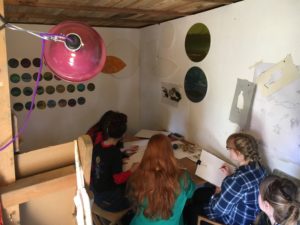Ropes of Light
Rope, light; both words suggest ideas of space and place: inside, outside; indoors, outdoors; sheltered, exposed; open, enclosed. All in all, they are also a matter of location, of situation. One might say the works which are part of Ropes of lightare landscapes, and could move on and try to build connections and a sort of aesthetic genetics with earlier works which might have been seminal in their creation. However, this might not be so relevant and helpful, if talking of landscape is a way to say that some works are more or less valuable or respectable than others, or if bringing the idea of landscape forces an imperative necessity to identify locations, physical features and events in a figurative mode.Although Wendy’s works feature titles with particular geographical clues and have been inspired by emotions felt in particular circumstances, this specific information might be more interesting from a documentary perspective than from an aesthetic point of view. Rather than asking the where-it-comes-from, or the who-and-what-inspired-it, both questions which – for a reason – inevitably lead to safe and reassuring answers, we might instead want to ask the what-we-can-do. If painting was edible, Wendy’s series/group/ensemble [?] would have to be slow food. Slow painting for discerning individuals sheltering from the constant and permanent visual shelling our post-modern culture induces. Slow painting, one which resists the quick skimming, the superficial glance, but needs sustained and repeated attention. For the one who takes care and pays attention, the unknown space of the image shall become a familiar place.
Ropes of lightsuggest a contradiction – apparent at least, between the thick of the rope and the thin of light. Both rope and light can be somehow light or heavy, thin or coarse, rough or soft. By chance or on purpose, all these textures make Wendy’s works in Ropes of light. Or is it that the contradiction would rather be a state of confusion? If figuration is assumed, discerning the land from the sky might prove difficult, as it can often be in various situations and places. There is also at times this unsettling thickness of the image, this granularity, which seems impenetrable, and balances at other times the smoothness of the glazing built up in the thick impasto applied under the palette knife, light and shiny. In other words, paintings resist, they open up as much as the viewer is ready to open themselves up to the work in this enduring conversation with the work no one ought to escape. We should be ready for this resistance, and reap the reward eventually.
Beyond the search in origins and the search in actual surroundings that they should evade perhaps more than any other work, what may be the most significant contribution/aspect of Wendy’s works is the search on oneself that they give an opportunity for.
Dr Guillaume Evrard (Art Historian, Edinburgh University)



